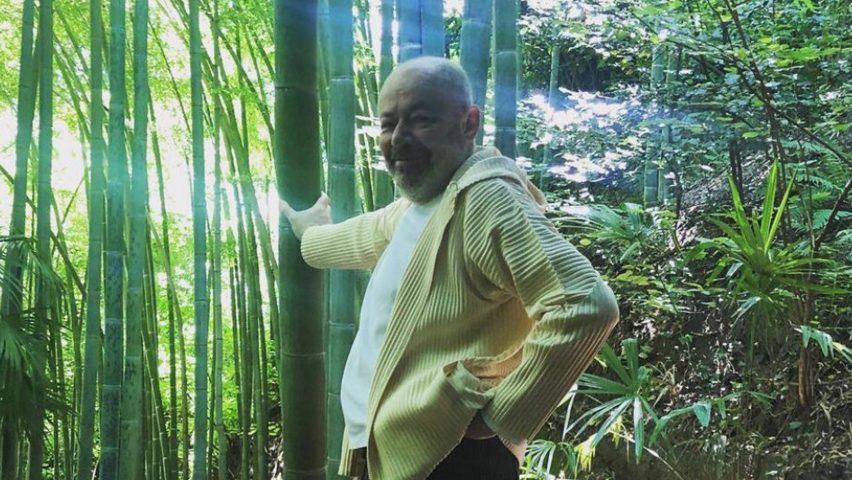
"Italo Rota's all-encompassing definition of architecture is needed today more than ever"
Architects should learn from Italo Rota's desire to constantly learn and evolve his view of architecture, Carlo Ratti writes following the Italian architect's death last week.
What is architecture? Every designer has his own definition. For Le Corbusier, it was "the skilful, rigorous, and magnificent play of volumes under light", while for Gio Ponti it was a quest: "sharp, essential, pure – pure as crystal". For Italo Rota it was something much broader: "architecture is a projection of the mind."
He used to repeat this sentence often, in a wry, mischievous tone, while stopping by our office in Torino, Italy. I believe that his all-encompassing definition of architecture is needed today more than ever.
The breadth of his interests was boundless and the focus of his projects diverse
Italo, who passed away last week aged 70, had a five-decade-long career marked by whirlwind mutations. While still a student he became a close collaborator of the great Italian neo-rationalist Franco Albini, then contributed to Vittorio Gregotti's 1970s megastructures, such as the Università della Calabria. Later, he became the lead architect for several neo-liberty projects by Gae Aulenti, co-signing with her one of the key museums of the time – the renovation of the famed Gare d'Orsay in Paris.
After opening his own office, he delivered some of the most interesting cultural buildings of the past decades – from the Cour Carré of the Musée du Louvre in Paris to the Museo del Novecento in Milan. Yet, if I had to attach a label to his oeuvre, I would say that he ultimately espoused only one movement: a continuous avant-garde.
The breadth of his interests was boundless and the focus of his projects diverse: only someone like Italo could create a spectacular augmented reality installation at the Milan Triennale for Samsung, and a handful of years later produce an Etruscan-style tomb for theatre director Luca Ronconi – the latter designed with Margherita Palli, stage-designer extraordinaire and Italo's lifelong companion.
His character is better grasped by dredging up voracious medieval sages like Ramon Llull than by comparing him to eclectic impresarios like Philip Johnson or Charles Moore.
Architecture as a "projection of the mind" also translated into his celebrated collecting passion – a magnificent Wunderkammer in his Milanese home today contains one of the most extensive collections of the architectural avant-gardes of the 20th century – and into a multiplicity of cultural interests, including artificial intelligence. He would constantly strive to explore digital advances firsthand – organising symposia and engaging with leading academics from all over the world.
His research was always embedded in academia, reflected in his role as director of the New Academy of Fine Arts (NABA) in Milan. His relationship with the revolving generations of students was another way to explore change; architecture as a projection of the mind needs to be redefined at every generation.
Together, we sought to explore the boundaries between the natural and artificial
He would listen to every new voice – something rare for academics, especially in Italy! – and absorb them into his personal, ever-evolving Weltanschauung.
His love for the living world was intense, and so too was his concern for the climate crisis. A few months before his passing, he left us a publication with a pantheistic title, Only Becoming Nature Will Save Us. Only if architecture can endorse a broader definition, it can play a role in today's defining crises.
We would often cite together Bucky Fuller's idea of a "utopia or oblivion moment". These words inspired the work we had begun together for the Venice Architecture Biennale 2025.
I was fortunate to collaborate with him towards the end of his career. Together, we sought to explore the boundaries between the natural and artificial – as in Francesco Mutti's tree-invaded home in Parma, or in the design for a radical decarbonisation scheme in Helsinki called the Hot Heart.
The last projects we did together will be presented this year at Milan design week – some organic structures made of rice for ENI at the Botanical Garden and an installation on circularity for Saviola, which reinterprets on a massive scale Louis Poulsen's PH Artichoke Lamp.
Italo's determination and imagination might have been at odds with his generosity and gentleness. However, they came together harmoniously in that fragile persona who arrived in our office clad in colorful Miyake Homme plissé dresses or original Red Guard uniforms – leaving captivated, fascinated, and filled every person who crossed paths with him with affection. Like architecture, clothing, as a second skin, is also a projection of the mind.
He was an innovator, the real kind
He was an innovator, the real kind. One of those who can focus not only on new solutions but on new questions (so much more difficult!). He always began with an extremely rational dissection of reality, which he then metabolised in his own unique way with expressions rich in poetry and metaphors.
When his illness surprised him a little over a year ago, we questioned him anxiously after his first doctor's appointment. What was the diagnosis? He quipped: "I fear that my body is about to lose symmetry". Together, we joked about this many times: it was about time, over a hundred years after Le Corbusier, to lose symmetry!
Now, without him, the loss is ours.
Carlo Ratti is an Italian architect who is the founder of Carlo Ratti Associati and director of the MIT Senseable City Lab. He will be the director of the Venice Architecture Biennale in 2025.
The photo is by Andrea Cassi.